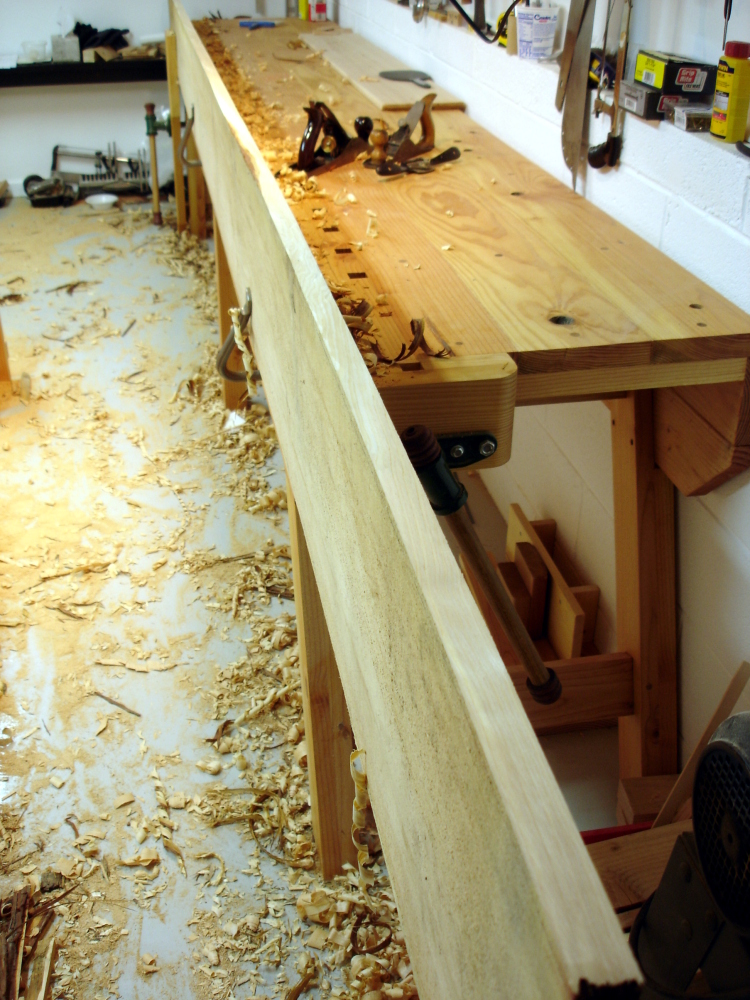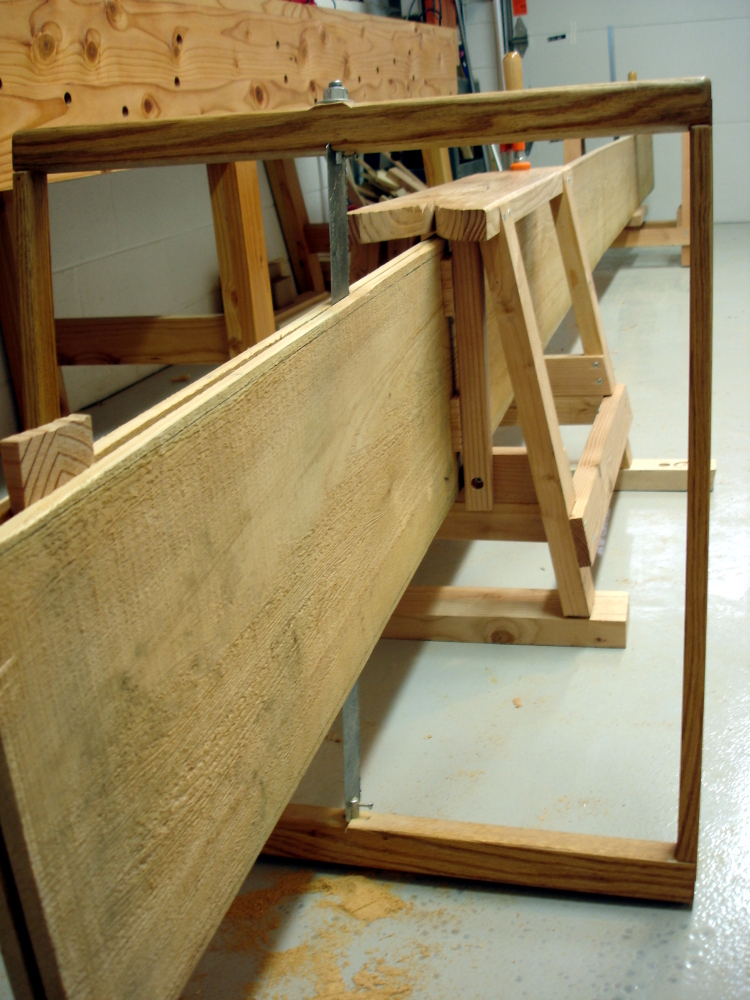The garboard planks on most boats are the largest. They are the lowest planks, the ones that attach to the keel or bottom. For this little boat, they are relatively narrow at the middle of the boat, but rise up to be quite wide at the ends of the boat. Then, we add in curvature, making the boards have a banana shape. That needs a wide board to start with.
I’ve saved the “big board” until now. It’s a beauty that is a bit over 12 inches wide at one end and 10 and 1/2 at the other. 16 feet long. Working this board helps one appreciate having a long bench. It also proves the ole galoot’s complaint that no bench is ever long enough. Here’s where the English style joiner’s bench with the front apron is valuable. Look closely for the holdfasts that help secure the board. The reason it’s on the bench is for edge prep, knocking off the raw edges and scoring center lines as guides for cutting.
My sawbench needed modification to hold this board. There wasn’t enough room under the top for the width of the board. Space was found by adding additional cross braces below those already there, and then cutting notches in the existing braces. That left me with a good way to hold the board, but a very short throw for the saw. So, you’ll see the sawbench sitting atop 2 by 4s to give a bit more throw; enough to do the job.
OK, I know. I know. You’re asking “Is this guy nuts? The lumber yard could have resawed all that lumber in about 15 minutes.” Yes, they could have, and would have almost doubled the cost of the lumber. Did I ever say I was a skinflint? I actually enjoy the work, especially since I can listen to Mark Levin or country music while working. Besides, while most galoots talk about their alcohol powered hand tools, mine are powered by Snickers bars.


I’m interested in knowing how long that cut takes after things are set up. Are we looking at a couple of hours here?
A couple more questions. What kind of blade are you using? Also, how do you tell if the cut is straight? Do you have to keep checking the bottom of the kerf?
Hi Luke,
Yep, it’s measured in hours. The narrower boards (8-9 inches) were moving along at about 3 feet per hour. This one is about half that. It will be a 2 Snickers bar board. Most of the rest were only one.
I’m also being extra careful with this one. The extra width could make it easier to go astray.
The blade is from a Disston D-8 rip saw. I cut it down to 2 inches wide and 24 long. It is 5 teeth per inch and I’ve refiled it for a more aggressive 90 degree angle. The first few feet of one of the boards is quite unruly as I tuned set and drift to get the blade cutting straight. Now, it cuts straight easily, as long as the operator stays off the alcohol.
I mark a center line pretty deeply on both edges of the board. I use that as a guide, and frequently examine the bottom edge with a hand mirror. If that bottom kerf starts to stray, flipping the board over and cutting from the other side gets the cut back in line.
That sounds like quite a bit of work.
One of these days I want to make (or have made) a frame saw for resawing, but I was thinking of buying the steel and making my own blade.
With boards that wide, it sounds like you would ideally have fewer teeth or even a raker tooth or skip tooth.
Also, I was wondering if a thinner kerf would help or if the saw would wander too bad.
I recently ripped some SYP that was about three inches wide with a 5 or 6 tpi rip handsaw. It went pretty well for me, but I don’t think it would have been any fun at all with wider boards using that particular blade and setup.
Excuse the scattered thoughts. I am just pondering the subject aloud…
The first blade I used was about 1 3/4 inch wide and a lot thinner. However, it was a peg tooth design that is much better for cross cuts. Very slow going.
I’ve tried a piece of bandsaw blade, 3 teeth per inch, with skip teeth. It was a 3/4 inch blade. It cut marginally faster, but was almost impossible to control.
This blade does have more drag than I like, but is a lot easier to control. I offset the drag two ways: with wedges that open the cut and by waxing the blade occasionally with a candle. It was a pretty good (and very old) D-8 that cut quite well before I cut it down for this purpose. It cuts even better now due to refiling the teeth at 90 degrees. They’re much more aggressive. I call the saw “wicked sharp.” When I use it to rip, the normal way, through 4/4 boards, the saw’s own weight does the work and rips about 1 inch per drop. For the 3 inch SYP, we’d probably have to push the saw, not just let it drop. 🙂 Maybe refiling for 3 teeth per inch would improve it a bit more. It was more than I wanted to do the last time around.
By the way, don’t shy away from making your own saw. It’s easy.
Thanks for posting and your comments. I may just try one in the near future.
Interesting post Bob! That English style joiner’s bench is handy. I really like the look of your setup with the saw benches. Does the bench move with you as you advance the kerf? After reading Luke’s comment, I was thinking that it does seem like less teeth per inch would help, with deeper gullets to hold the sawdust. But that got me wondering about saw and throw length. It seems that ideally, you would want a blade long enough that the first tooth in would also emerge out the other side to drop its dust. Of course, that would require enough room for a long throw. Hmm. Might require some kind of overhead, saw pit type setup. Probably not practical…
Are you strictly a Snicker’s guy, or do you ever mix it up?
Hi Dan,
The lumber is clamped and wedged to the sawbench. Every 18 inches or so, I loosen the clamps and move the sawbench about that far down the board. Sitting on the end of the bench, I find 18-20 inches about as far as I want to reach.
Fewer teeth per inch might help. Deeper gullets might also help too. I used 5 tpi because that was the original filing of the blade on hand and I had no experience to suggest otherwise. Because of the way the work is held, throw distance is relatively short, 4 – 7 inches depending on the board width. Dust clearance is sub-optimal but I’ve found that sawing at varying angles helps with that. I’ll have more about this is a tutorial shortly.
Snickers, Milky Way, almost any other chocolate. Actually the chocolate is relatively infrequent. What really powers the tools is coffee, coffee, coffee.